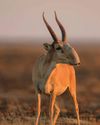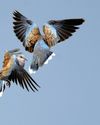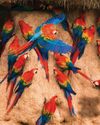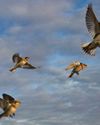
ONE OF THE MOST JOYOUS AND TIME honoured festive traditions for many this month must surely be decorating 0 the Christmas tree. But while adorning the tree in the warmth of your homes, do spare a thought for the feathery baubles festooning a number of urban trees outdoors, as pied wagtails join forces each dusk to collectively see out the long, cold winter nights.
Identified by their monochromatic plumage, jerky walk and habit of constantly pumping their long tails, pied wagtails are without doubt one of the most beloved members of our wonderfully diverse avifauna. Breeding across most of Britain, these adaptable little birds are often, but not
Did you know?
One theory for why pied wagtails wag their tails is that it helps flush out their insect prey always, close to water and tend to prefer 'open country' in farmland, moorland and even town parks. Insectivorous by nature, their favoured food is taken from the ground, the water's surface or snatched midair. Flies, midges and caterpillars are popular meals.
Esta historia es de la edición December 2023 de BBC Wildlife.
Comience su prueba gratuita de Magzter GOLD de 7 días para acceder a miles de historias premium seleccionadas y a más de 9,000 revistas y periódicos.
Ya eres suscriptor ? Conectar
Esta historia es de la edición December 2023 de BBC Wildlife.
Comience su prueba gratuita de Magzter GOLD de 7 días para acceder a miles de historias premium seleccionadas y a más de 9,000 revistas y periódicos.
Ya eres suscriptor? Conectar

SNAP-CHAT
Justin Gilligan on giant spider crabs and holding hands with an octopus

STEPPE CHANGE
Herds of saiga have returned to Kazakhstan, but there's a fine balance to tread

TREES FOR LIFE
Community is at the heart of conservation in the tropical forests of southern Belize

WHEN DOVES CRY
Turtle doves are now the UK's fastest declining bird species, but the RSPB is on a mission to save them

SURVIVAL OF THE CUTEST
We can't help being drawn to cute creatures, but our aesthetic preferences both help and hinder conservation

LIGHT ON THE NORTH
Spectacular images of Arctic foxes, reindeer and musk oxen reveal the wild beauty and diversity of Scandinavia

ROLLING IN THE DEEP
The super-sized crustacean that lives in the deepest, darkest ocean

LET'S GET TOGETHER
Clay licks deep in the Amazon explode in a riot of colour, with macaws the stars of the show

FEMALE OF THE SPECIES
To sponge or not to sponge? That is the question for the bottlenose dolphins (Tursiops aduncus) living in Shark Bay, Western Australia.

7 nature encounters for the month ahead
WITH NATURALIST AND AUTHOR BEN HOARE